Александр Левченков
Александр Левченков и Мария Молодых

Александр Левченков и Мария Молодых – это творческий и семейный союз двух художников – двух личностей с яркой индивидуальностью живописного таланта каждого. Оба они – профессиональные живописцы, прошли серьезную подготовку от художественной школы до аспирантуры, получив тот обучающий максимум, какой только может дать современное художественное образование в России. Однако путь каждого из художников в искусстве уникален неповторимостью человеческой судьбы.
Александр после художественной школы осваивал миниатюрную живопись в Федоскинском художественно-промышленном училище, и, видимо, отсюда берет начало его любовь к деталям, к предметному миру. Затем учился в Российской Академии живописи, ваяния и зодчества имени И. С. Глазунова, специализировался в мастерской портрета профессора Л. С. Хасьяновой, там же проходил аспирантуру. Некоторое время преподавал, но стремление целиком «погрузиться» в творчество вытеснило другие занятия из жизни.
Творческое портфолио Александра настолько обширно, что трудно поверить, что все это многообразие больших и малых форматов, разных по жанрам и даже стилям, создано одним, еще молодым человеком.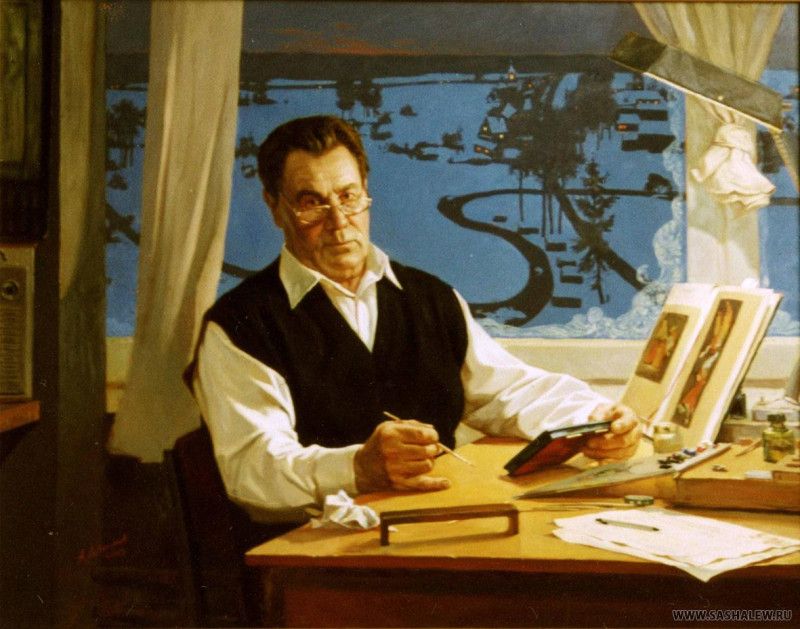
Наверное, раньше всего в нем «заговорил» портретист, и первые значительные результаты были замечены уже в годы обучения в академии в 2003-2005 гг., когда художник создал серию портретов художников – мастеров федоскинской народной живописи. С тех пор и по настоящее время портретный жанр продолжает оставаться ведущим в творчестве Александра Левченкова. И не только потому, что в наше время, как и в XVIII-XIX вв. портрет весьма востребуемый на рынке картин «товар». Скорее потому, что Александру интересны люди. И это – редкий дар в современном эгоистическом мире. Чтобы писать портреты недостаточно уметь передавать внешнее сходство с моделью. С этим успешно справляется фотоаппарат. Важно почувствовать личность портретируемого, понять характер человека, увидеть лучшее, значительное, и показать увиденное зрителям. Александр мастерски пишет портреты: парадные и сентиментальные, в жанровых сценах или как образец салонной живописи начала ХХ века, в пейзаже и в интерьере, в традициях европейской и даже японской культуры.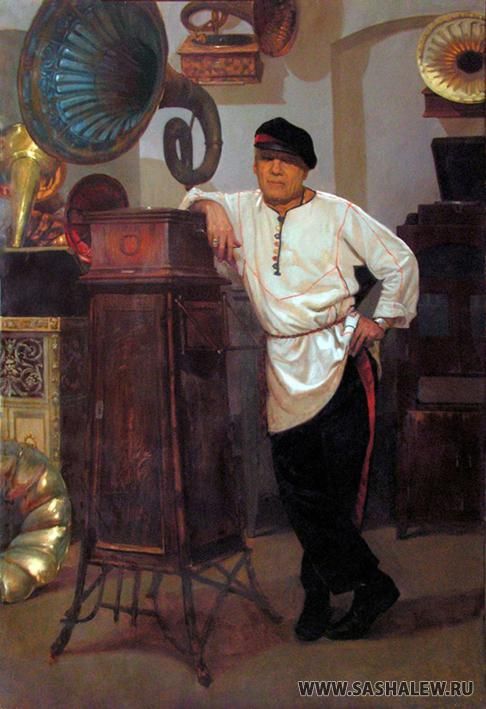
Большинство его работ принадлежит к разновидности жанрового портрета, который предполагает повествование о человеке через предметный мир вокруг него. Портрет известного циркового артиста и коллекционера граммофонов В. И. Дерябкина – одновременно и жанровый сюжет, в котором обстановка сама рассказывает о герое, его прошлом и настоящем.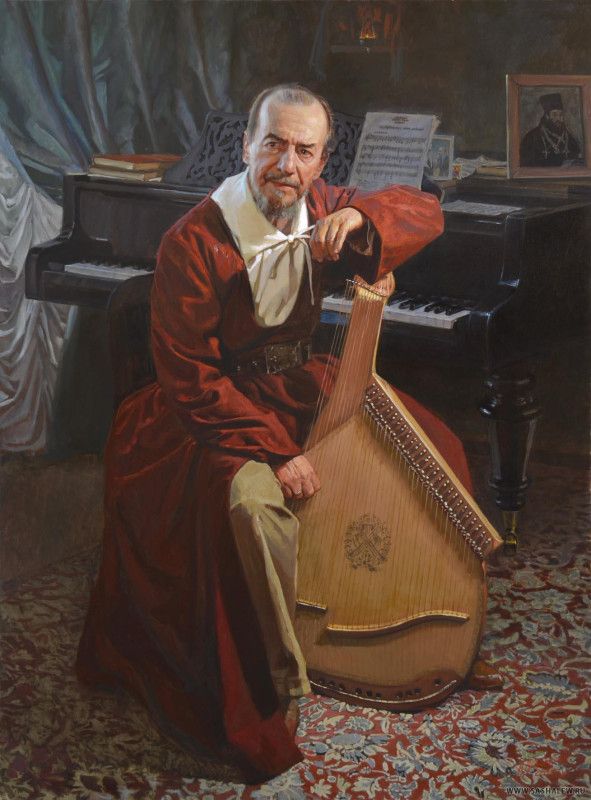
В портретном изображении В. Г. Захарченко – руководителе Кубанского Казачьего хора – музыкальные инструменты, сценический костюм, мягкий свет от лампады перед иконой в углу – так же необходимы для характеристики личности композитора, как и пронзительный взгляд, красивые сильные руки музыканта. Легко заметить, что Александр склонен изображать людей творческих профессий, особенно часто – артистов или тех людей, кто избрал сложную, значительную жизненную роль.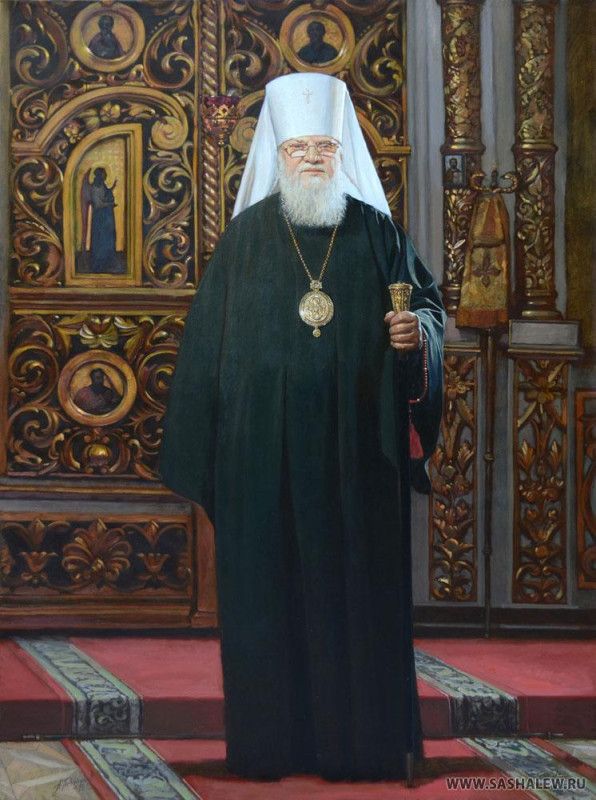
Портрет Митрополита Екатеринодарского и Кубанского Исидора, написанный в интерьере храма, представляет зрителю сильный и даже суровый характер владыки, человека значительного, облеченного властью и обремененного серьезными заботами. Скромное одеяние контрастирует с великолепием храмового окружения, все внимание сконцентрировано на создании образа духовного благородства и мощи.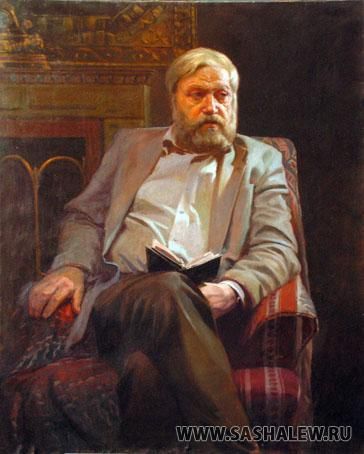
В портрете правнука Ф. М. Достоевского – Дмитрия Андреевича Достоевского, мы видим представителя российской интеллигенции с благородной сединой в волосах, с книгой в руках. Достаточно прочитать его фамилию, как происходит мгновенное «узнавание» никогда ранее не виденного человека и множество нюансов «подсказывает» нам черты характера и душевный склад потомка великого русского писателя.
В детских портретах Александра привлекает возможность показать мир безоблачных эмоций и яркой радости. Искрящиеся глаза, особая чистота и незамутненность образов, обычно представленных в моменты игры или созерцательного мечтания – составляет главное очарование этих работ.
Необычайно изысканы костюмированные портреты, исполненные Александром с использованием театрального реквизита. Этот живописный жанр известен в России с середины XVIII века: когда портретируемый изображался в каком-либо эффектном историческом или театральном наряде, отличном от общепринятой одежды своего времени. Так, портрет Лены Лениной в образе боярыни в роскошном старинном наряде из тяжелых драгоценных тканей, в жемчужном уборе и зеркальцем на вытянутой руке вызывает ассоциации с царевнами русских сказок и одновременно намекает на статус героини портрета в современной жизни.
Ряд портретов в духе салонной живописи начала ХХ века демонстрируют нам не только виртуозное владение разными живописными приемами и стилями, но и прекрасное знание истории искусства, а также внимательный, скрупулезный исследовательский подход к таким «ретро» изображениям. Вот портрет легкомысленной кокетки Анны, с сигарой в артистически отставленной руке, юная дама поправляет прическу, привлекая внимание к лицу. Героиня изображена женственной и шаловливой, в изумительном платье с переливчатыми складками шелка, свидетельствующими о хорошем знании голландской живописной традиции XVII века с ее особым вниманием к фактурам тканей. В этой картине художник создал образ молодой интеллигентной особы с независимым характером.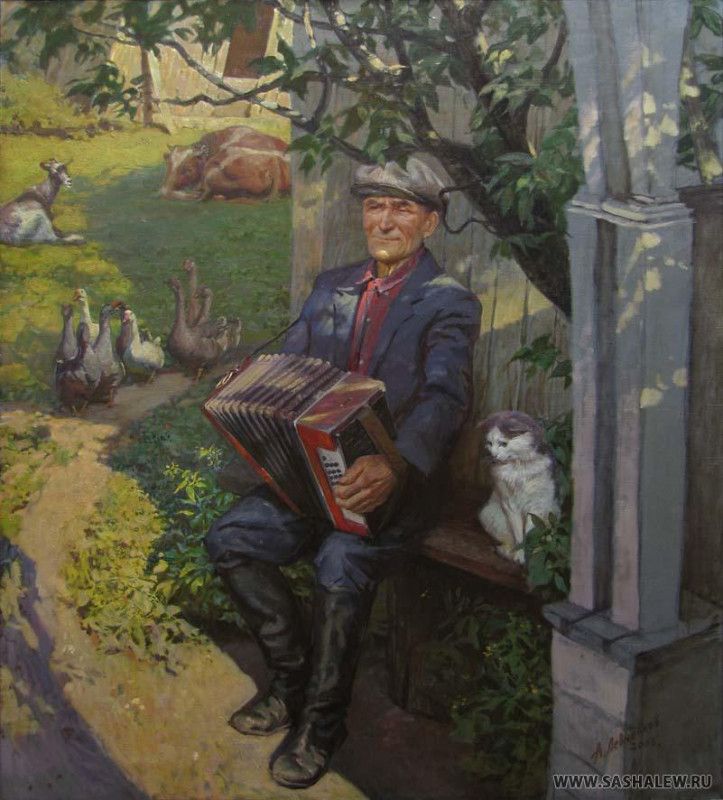
Жанровые сценки из сельской жизни – другая грань таланта Александра: «Лето в деревне» (1998), «Деревенский почтальон» (1997), «9 мая. Гармонист» (2006) и другие показывают зрителю жизнь российской глубинки на рубеже ХХ-ХХI века, с мягким юмором и большой любовью к людям, чья жизнь часто лишена городских удобств и совсем не изыскана, но сами люди – прекрасны в своих человеческих чувствах: надеждах, радостях, горестях и воспоминаниях. Художник в этих картинах далек как от критического отношения к реальности, так и от романтизирования деревенской жизни. И не вызывает сомнения, что значительная часть героев этих сценок имеет портретное сходство с реальными людьми – нашими современниками.
Огромную часть творчества Александра составляют портреты, написанные в качестве этюдов к большим историческим картинам. Многие из них совершенны по исполнению и являются самостоятельными живописными произведениями.
Женские образы – «Мария Темрюковна» (2009), «Боярышня со свечой», «Крестьянка» и мужские – портреты кубанских казаков, древнерусских воинов представлены художником как средоточие лучших человеческих качеств, как квинтэссенция духовной силы народа.
Этюды созданы как подготовительные фрагменты для больших исторических полотен, которые занимают особенное место в творчестве Александра Левченкова.
Современные художники редко работают в жанре исторической картины. В первую очередь потому, что это - почти всегда заказы работа на заданный сюжет, в которых, кажется, мало простора для творческого самовыражения, а вот знаний, умений и исследовательской работы требуется с избытком. Именно поэтому самыми «ходовыми» жанрами в современном искусстве стали натюрморты и пейзажи. Небольшой размер подходит практически для любого интерьера, обезличенность, без «привязки» к конкретной ситуации или персоне позволяет продавать натюрморты и пейзажи в магазинах как любые другие предметы обстановки интерьера.
В случае с исторической картиной все фундаментальнее, значимее: заданный сюжет, чаще всего из прошлого, множество действующих лиц, определенное, всегда узнаваемое место действия налагают на художника большую ответственность и требуют максимального профессионализма. Александр Левченков – один из немногих современных российских художников, кто уверенно и грамотно решет сложные композиционные и живописные задачи в историческом полотне. Этот жанр в живописи не без основания считается одним из самых сложных. Он достиг своего расцвета в России в XIX столетии в работах В. И. Сурикова И. Е. Репина, И. Н. Крамского. В советское время был мало востребован в связи с преобладанием в искусстве историко-революционных сюжетов, окрашенных оценочной идеологией социализма. И только в конце ХХ века вновь возник интерес к далекому историческому прошлому страны, а современная политическая ситуация заставляет выстраивать ретроспективу для понимания истоков животрепещущих событий нашего времени. На этом фоне историческая живопись вновь набирает популярность.
Жанр исторической картины не существует в «чистом» виде. Невозможно написать сюжет из прошлого без связи с конкретными историческими лицами, предметами быта, архитектурным пейзажем или интерьерной обстановкой. Именно поэтому работа над историческим полотном требует от художника не только «погружения» в ткань событий прошлого, но и умение изобразить деятелей эпохи, отличного знания предметного мира разных эпох: одежды, утвари, стилей в архитектуре и конкретного облика зданий в то или иное время. Это все необходимо, чтобы создать впечатление правдивости как в изображении исторических персонажей, так и в деталях обстановки. И здесь мастерство Александра Левченкова - портретиста блестяще дополняется его внимательным отношением к предметам, наполняющим пространство человеческой жизни. Изучение бытовой культуры эпохи по сохранившимся музейным образцам, собственная коллекция вещей разных времен, накопленная в семье художников, отражается в бесчисленном числе этюдов с предметами, фрагментами обстановки, портретами разных людей: все это составляет длительный, но необходимый процесс создания большого исторического полотна.
Историческая картина сегодня, как и в XIX столетии, является вершиной мастерства и профессионализма живописца, ведь соединяет в себе все жанры живописи. В творческом портфолио Александра есть картины из разных периодов отечественной истории: от древнерусского периода – до наших дней. И картины о современных значимых событиях, как, например, «Эстафета Олимийского огня 2014 г.» продолжает традицию российской исторической живописи уже в XXI веке.
Мария Молодых – спутница жизни Александра Левченкова – родилась в семье художников и продолжает дело целой творческой династии Скориковых. Она признается, что ее детство прошло в художественной «муштре» и постоянном обучении, прежде всего у родителей. Сегодня она с благодарностью вспоминает родительскую «выучку» и привитую с детства привычку к творческому труду.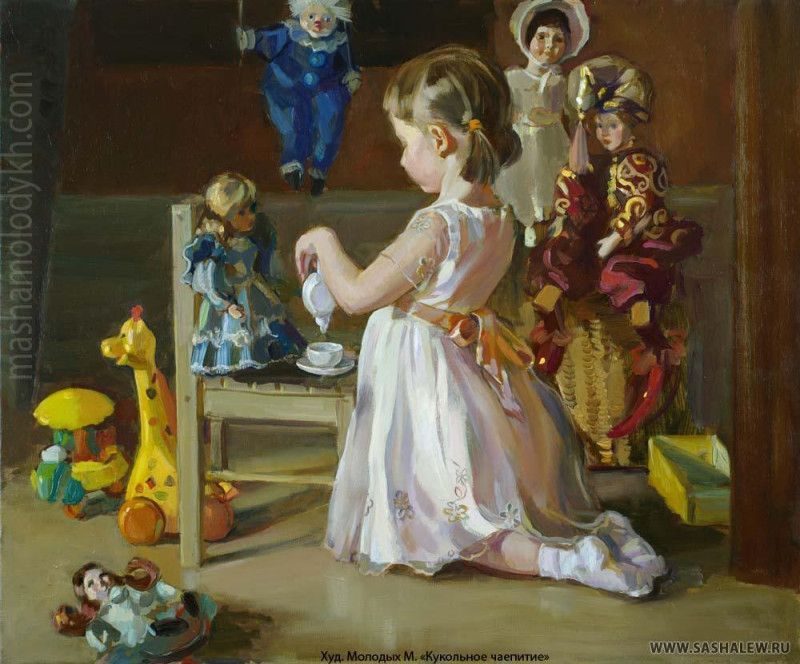
Мария – петербурженка, закончила училище им. В. А. Серова, затем Государственный Институт Живописи, Скульптуры и Архитектуры им. И. Е. Репина, где специализировалась под руководством профессоров Ю. М. Непринцева и О. А. Еремеева. В ее творчестве преобладает женская тема, и воплощена она в основном в жанровых работах. В этих картинах отчетливо прослеживается мировоззрение художницы, ее понимание роли женщины в жизни, как матери и хозяйки, сочувствие переживаниям и эмоциям ее героинь.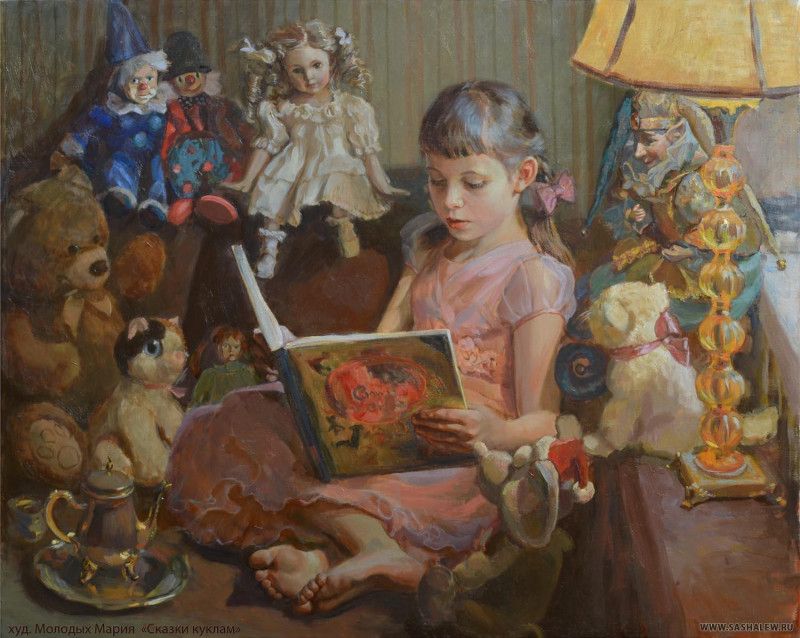
Предназначение женщины проявляется с детства и связующей нитью судьбы проходит через все события ее жизни: вот девчушка читает книжку игрушечным слушателям («Сказки куклам», 2014 ), играет в хозяйку, «понарошку» разливая чай («Кукольное чаепитие»), вот девушки-болтушки плетут венки за разговором («Девочки на поляне»), невеста в свадебном уборе, вот молодая женщина с грустными глазами примеряет украшение в чисто убранной избе («Голубые бусы»), боярышня в богатом наряде XVII века ласкает кота («Боярышня с котом»), радости материнства и подросшие дети, вот старенькая бабушка чаевничает, коротая дни у камина («Старый Петербург. Моя бабушка»), - все эти возрастные вехи типичны для каждой женщины в любые времена. Эти женские роли – вне времени и эпох, так было, есть, и хорошо, если будет.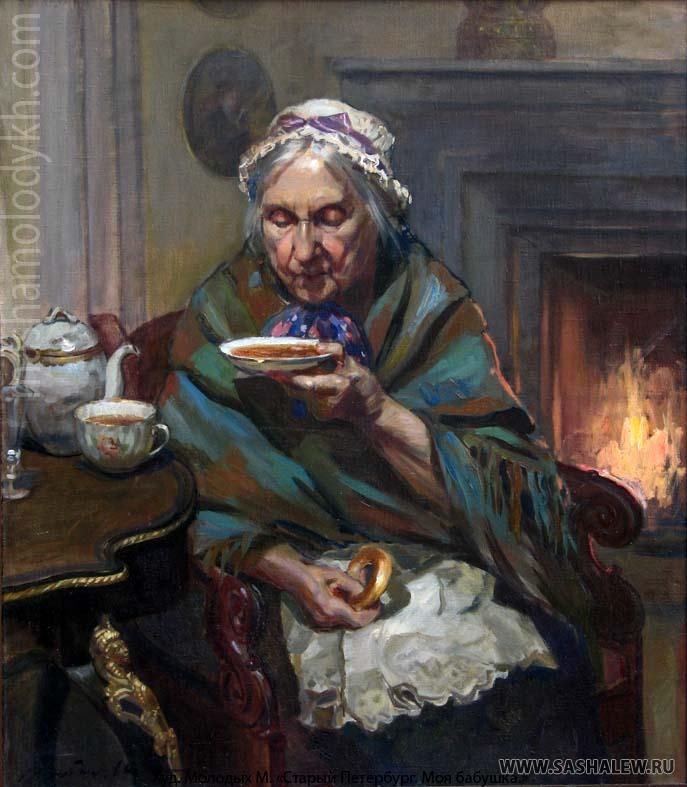
В «Портрете бабушки» зрителя настигает пронзительное щемящее чувство, где за бытовым сюжетом угадывается глубокое смирение и философское принятие заката человеческой жизни.
Женственные, мягкие, любящие, грациозные девочки, девушки, женщины, старушки, написаны с теплом и проникновением в мир женских эмоций и чувств, праздников и превратностей судьбы.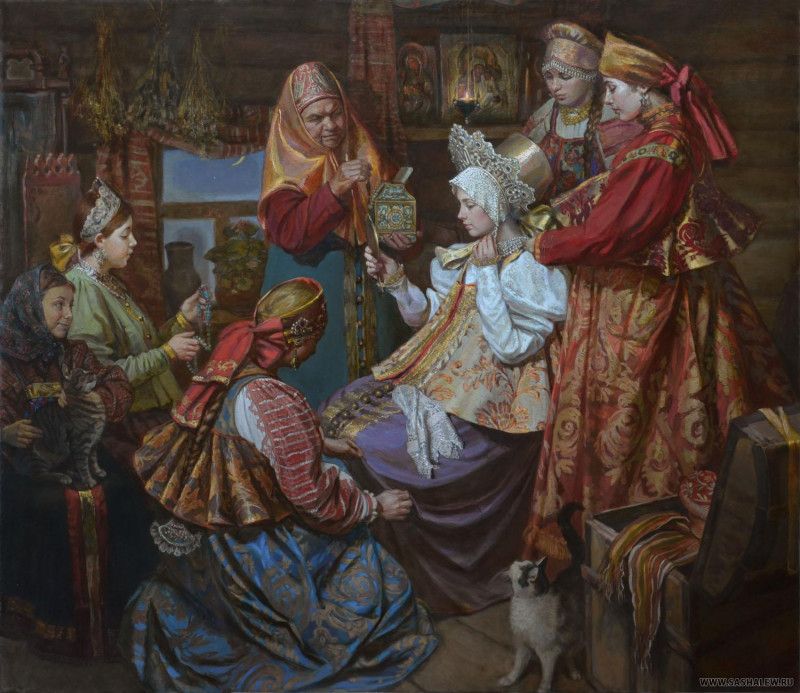
Некоторые работы портретны, но каждый женский образ одновременно и собирательный, в котором воплощены представления художницы о лучших качествах женщины: это сочувствие, любовь и забота, и главное – осознание своей судьбы.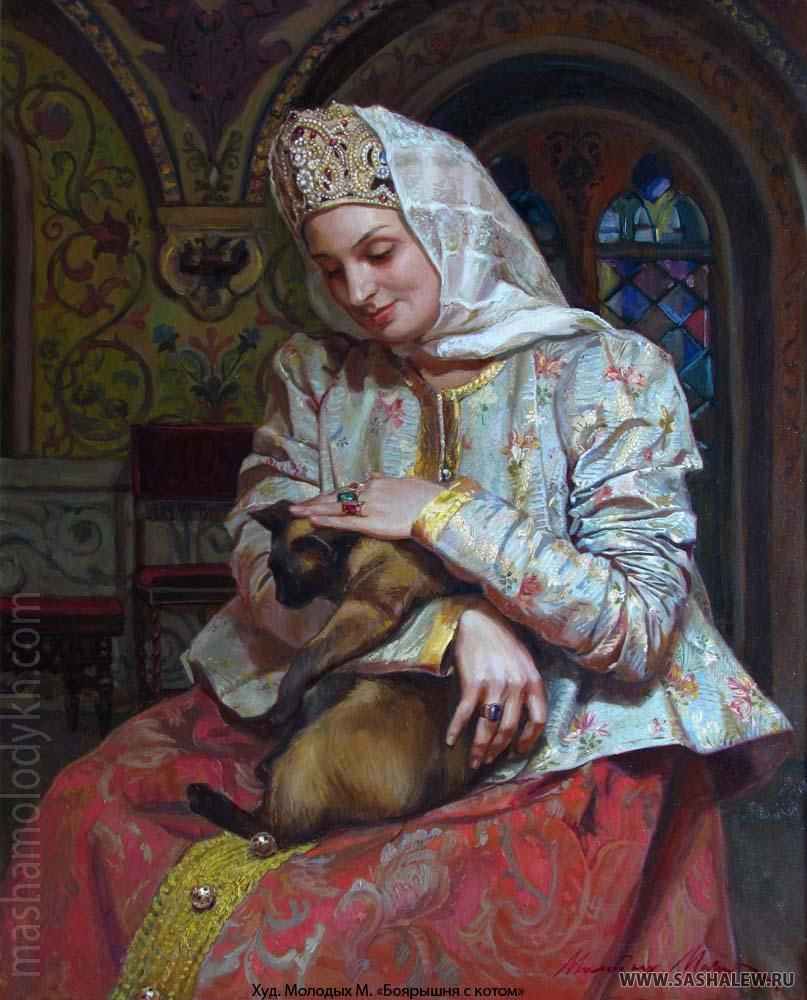
Особенно изысканы и красивы по колористическому строю картины с изображениями боярышень в исторических костюмах. Страсть к украшениям, характерная для женской натуры, представлена в работах Марии Молодых как естественное стремление к красоте и гармонии.
Героини картин «Шкатулочка», «Новые сережки», «Батюшкин подарок» в ярких нарядах, с радостными лицами, пышущие здоровьем, телесной и душевной чистотой, сами выглядят как драгоценность в узорчатых богатых покоях. Молодые женщины, любующиеся собственной красотой – это символ той гармонии, что вносит женское начало в жизнь. Все женские образы в творчестве Марии Молодых отмечены праздничностью, их отличает поэтичность и внутренняя цельность.
Манера письма Марии Молодых – широкая, без миниатюрной прописки в деталях, привлекает своей раскованностью и свободой. Ее пейзажи с жанровыми сценами из современной жизни отмечены поэтичностью в изображении старинных городов России. Картины «Улочка в провинциальном городке», «Старый Краснодар. Арбузы», «На Заречной улице» рождают светлое чувство погожего дня с солнечными бликами на домах незамысловатой архитектуры, ощущение значимости и полезности занятий людей, создают совершенно особенное настроение эмоционального подъема и безотчетной радости бытия.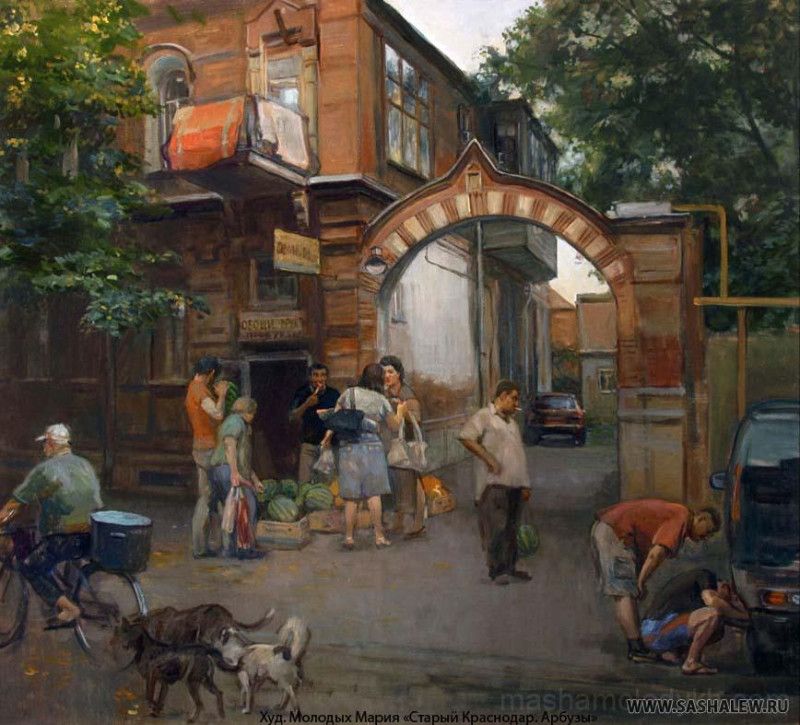
Александр Левченков и Мария Молодых – разные художники, но семейная жизнь привела их и к совместному творчеству. В истории искусства работа нескольких человек над одним произведением – не редкость. Александр и Мария пишут некоторые картины вместе, работая каждый над своей стадией письма. Совместная работа, обогатив манеру каждого, сблизила их творческий почерк так, что в некоторых случаях без подписи под картиной не разобраться, кем именно она написана.
Одновременная работа художников над «балетной» темой привела к появлению большого числа превосходных картин с изображениями артистов театра Ю. Н. Григоровича. Инициатором была Мария, ее давно привлекала эта тема. Замысел получил развитие после того, как в 2015-2016 гг. художники всей семьей посетили несколько балетов Григоровича. Эти представления доставили им глубокие эмоциональные и эстетические переживания. Мария и Александр рассказывают, что поразило их буквально все: и само сценическое действие, и костюмы артистов, и техника исполнения танцев, прекрасные декорации и, конечно, музыка, все счастливо сложилось в тот самый синтез искусств, который составляет суть театрального действа.
Удовольствие и катарисис, испытанные во время представлений, подтолкнули художников к решительным действиям – они отправились в театральную дирекцию на переговоры. В результате для них были организованы условия для знакомства с устройством театрального закулисья и жизнью балетной труппы. Полтора месяца Мария и Александр ходили на репетиции и представления, много времени проводили за сценой, вникая в театральные будни артистов, наполняясь уникальными зрительными впечатлениями, и конечно, много работали: с каждым из артистов провели по несколько живописных сеансов, писали этюды с натуры. В результате было создано десять портретов артистов балета Ю. Н. Григоровича и множество жанровых картин. Потом была выставка «Антре» в музее им. Ф. А. Коваленко в Краснодаре, часть работ осталась в Краснодарском музыкальном театре, и вероятно, в скором времени украсят его фойе.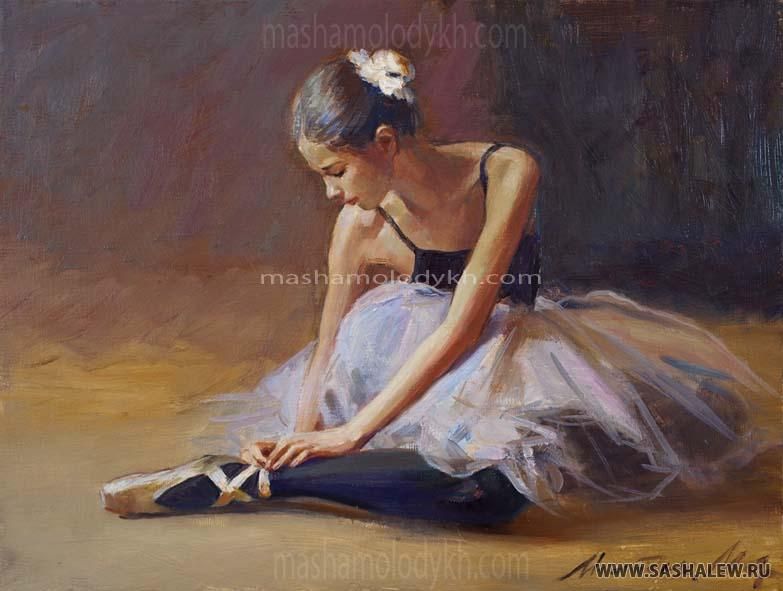
Очаровательны портреты юных танцовщиц в скромных рабочих костюмах, но с неизменной белой пышной юбочкой, как олицетворение женской грации и красоты. Мария Молодых в работах на тему балета продолжает «женскую тему». Ее героини-балеринки хрупкие и сильные одновременно, нежные и осознающие свое предназначение как служение людям и искусству. В этих работах почти нет обстановки, деталей окружения, все внимание зрителя Мария направляет на личность артиста, часто еще совсем юного существа, недавно расставшегося с детством.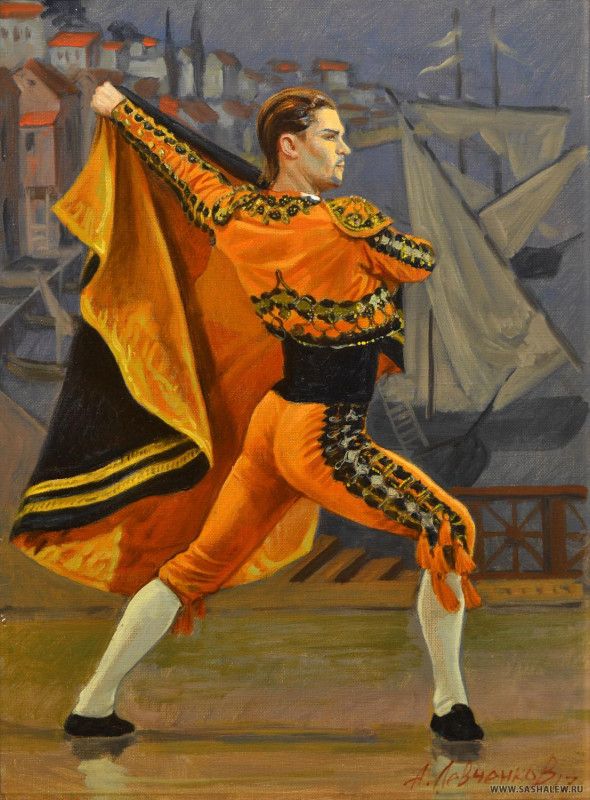
Александр, в силу своего мужского менталитета, предпочитает изображать внешнюю сценическую жизнь актеров. Театральные наряды, эффектные позы, яркие цвета создают ощущение праздника. Он показывает артистов балета в кульминационные моменты театрального действия, в моменты максимального выявления образа исполняемого героя.
Эти картины переносят зрителя в мир сильных эмоций, передаваемых через пластику тела, движение, позу, яркий костюм. Царственный визирь (Е. Ланцута), грустный Пьеро (А. Акименко), шаловлива Никия в восточном наряде (М. Фадеева), огненный тореадор (Е. Ланцута), лохматый и эксцентричный трубач (А. Ломакин) – не просто персонажи театральных постановок, это – портреты артистов – людей, которые силой своего искусства перевоплощаются на сцене в другую личность.
Александр Левченков и Мария Молодых – цельные творческие личности, которым рано посчастливилось найти свое призвание. Они успешны успешностью творческих людей: ставят внутренние цели и достигают их, постоянно совершенствуя свои способности, находятся в поиске и равняются на великих мастеров живописи прошлого и современности.
Творчество этих художников продолжает реалистическую линию русского искусства, идущую от передвижников и знаменитых русских живописцев – И. Н. Крамского, В. И. Сурикова, В. Д. Поленова, И. Е. Репина – продолжает в современных жанровых сюжетах и портретах наших современников – как людей из провинциальной глубинки, так и ярких представителей творческой и духовной интеллигенции России.
